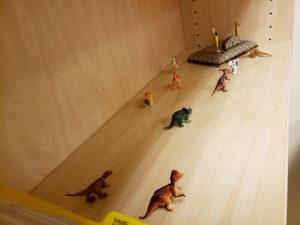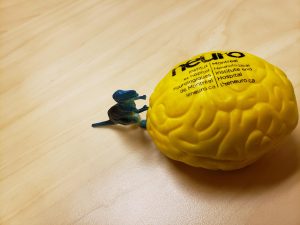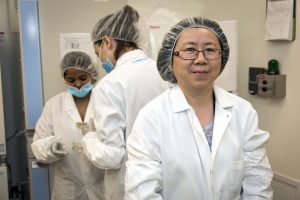In the immortal words of Ron Burgundy “Its so hot… milk was a bad choice”. Man, it is a scorcher today, with a humidex of really humid, now I know how cells feel like living in an incubator. But when its hot, what better way to cool down then with an ice cold beverage (I mean freshly frozen tube of stem cells). As promised, the continuation of Tuesday’s blog in which we learn to maintain iPSCs, to split iPSCs, and yes, as it says it in the title, to freeze down iPSCs. Before I get started, I have been inundated with requests from people asking how the dinosaurs are doing, I don’t know if they are mocking me, or if they are serious. But thank you for asking, they are doing well and no they don’t have their own instagram account, here is my first and last picture of my collection as they like their privacy. As you can see, blue has a special place in my heart looking after my stress ball brain, he sits in on all my meetings giving constructive advice as we all work to take a bite out of the modern scientific problems of our day (haha, sorry that was an awful pun, please forgive me).


Ok, enough of the fun and games, lets get down to serious business. Your cells are attached and growing, so every day you must now keep an eye on them to make sure they are happy. Also, every day you need to change the media. How all this works is in the SOP we published on Tuesday. There are some new approaches in which you can skips days but the preference for our group is daily media changes. As your cells grow, they will form tightly packed colonies that grow and expand in size over about 6-7 days until they reach confluency. But the growth rate can vary from line to line, and depends on the media you use, so be mindful of this when doing your cultures. Also look out for differentiation, or when the cells become bad. This is like when they lose their superpowers and are no longer a superhero but just a regular person, or in stem cell terms, they lose their pluripotency. Images of what this looks like are below, monitor daily for the bad cells, when you see them try to remove them, it helps in keeping the cells all nice and pluripotent.

Once the cells have reached critical mass and in our SOP, we have recommendations on when this is, then you are ready to passage. This means removing the cells from the dish they are on, to put a small amount of these cells onto a new dish to grow again. To do so, we use gentle cell dissociation media to lift the cells from the plates. These cells are pelleted, resuspended in media, and then carefully, pipetted to break the aggregates down to add onto a new plate. This plate is coated like we describe in Tuesday’s blog. If you don’t have a coated dish, then gulp. You better pray someone else does, or your best bet is to simply freeze the cells down.
Now for freezing cells, its pretty much the same as passaging, with one small exception, this is the end of the cells current journey as they are heading to the liquid nitrogen tank in the big storage room down the hall. Once you have your cell pellet, resuspend in freeze down media, and calculate the cell viability and total cell number. Based on your numbers, pipette your cell suspension into multiple cryogenic vials, and then voila, ready for the freezer. This is a stepwise freezing process, so start at -20 degrees, then -80 after a few hours, and then the next day to their final destination, the liquid nitrogen tank where it stays until you need it again, or until someone else needs it.
So there we have it, the highest-level overview of doing iPSC culture, but all the details are here. Everything we do is outlined in the blog and here, I can’t take the credit, actually I get zero credit, this is all my team, I just write about it. The real credit in particular goes to the person who trained me on iPSCs, and who is my real boss, Dr. Carol Chen pictured below. Fun fact about Carol, she started a year before me in the lab, and I have driven her crazy every day for 12 years, but she is a fountain of knowledge and puts my lab skills to shame, while keeping a steady flow of chocolate coming my way. She trains everyone in our group for iPSCs, and when people need to be trained from other groups, she is the go to person for helping people to learn and is one of many great team members I get to come and work with every day. You will get to meet many of them in the coming weeks and months.

And its not just our regular SOP that we use for training. We are trying something a little different and more immersive, so this is brand new and we hope you like it. If you have comments or feedback we would love to hear from you and this goes for all SOPs, if you think, oh gosh Tom, your such an idiot, then please tell me, we want to do the best work we can and if people have advice then please lets talk, if you have editing errors you spot, then please go ahead and provide me a list. As you can tell, I wasn’t very good with English grammar at school.
Now for our SOP pdf, we took it, tore it apart, put it back together again and created a hands-on training module, that is now on tablets in our culture room. This means when people learn iPSCs, no need for paper. A real-time, clickable SOP on a tablet for people to work off, paired with the interactive reagent list. All credit for this goes to Carol Chen, Cecilia Rocha and Trisha Rao who took this on board and led this, and I hope you agree with me, its great and we are hoping to test it over coming months within our group and adapt it for a number of our other protocols. And hopefully it will be a great learning tool for anyone new who wants to work with stem cells no matter where you are.
Ok, so this is our first part done, three blogs down, seven to go. You sick of me yet, course you are. My dedicated fans still stick with me (hi mom) Next week, we will discuss our pipeline for monitoring iPSC quality. For this, I will be making available Carol’s poster from the ISSCR meeting in LA a few weeks ago, which I know you will all love. So enjoy the weekend and after all this talk of cold drinks, I better go get myself a cold beverage and cool off. Over the next week will try something new which is hats. As I approach 40, I am trying new things, so hats seemed like a good thing to try, I might have a picture next week of me in a hat depending on how I think i look, and we can decide if its good or bad for Tom to wear a hat with my sizeable noggin. Until next week, you stay classy San Diego.
